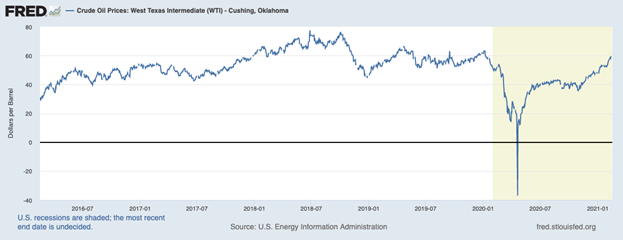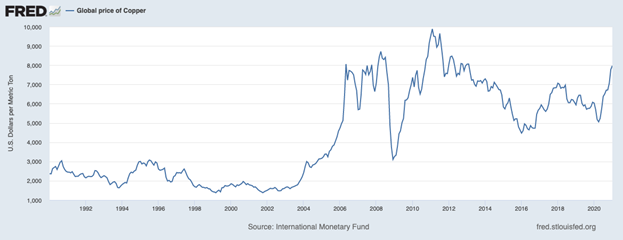By MITCH ZACKS
Broad equity markets have rebounded strongly from last year’s pandemic-induced recession, but they’re not the only asset class seeing strong gains.
Commodities are on the upswing, too.
As of last week, the Bloomberg Commodity Spot Index was up over 60% from the pandemic lows touched last March, and even still, many individual commodities have not climbed back up to pre-pandemic prices. As you can see in the series of charts below, everything from copper, to oil, to lumber is seeing upward price pressure:
Crude Oil Prices: West Texas Intermediate (5 Years)

Source: Federal Reserve Bank of St. Louis
Metals: Producer Price Index (5 Years)

Source: Federal Reserve Bank of St. Louis
Lumber: Producer Price Index (5 Years)

Source: Federal Reserve Bank of St. Louis
Copper Prices (1990 – Present)

Source: Federal Reserve Bank of St. Louis
Explanations for why commodities are seeing upward price pressures are many. They range from increased demand coming off pandemic lows to the impact of extraordinary fiscal and monetary stimulus, to surging demand for lithium and copper needed for electricity and electric vehicles, to governments posturing for big infrastructure spending plans, to the global economy at the cusp of another commodity supercycle.
I have noticed the appearance of ‘commodity supercycle’ quite a bit of late, which makes me think people may be over-committing (and getting too optimistic) to the possibility.
The reality of commodity price pressures could be because of none of the above factors, or all of the above factors. My point is this: investors should avoid trying to forecast commodity cycles and prices too far into the future. I agree the 2021 outlook for commodities, and by extension Materials and Industrials companies, is positive. But I don’t think it makes sense to forecast too much further than that.
Most economists and market historians would agree that there have been four commodity supercycles in history, with the last one starting around the mid-1990s. Many readers may remember the powerful rise of Emerging Markets and in particular, China, in the 2000s. Historic infrastructure build-outs across the developing world – and a weak U.S. dollar – helped drive a significant portion of that supercycle, which peaked in 2008 and arguably ended sometime in the last decade (still being determined).
We know the 2008 Global Financial Crisis gave way to middling global economic growth, and it also hurt the Emerging Market’s ability to access debt markets. Commodities suffered during this period, and more recently, trade wars and the global economic shutdown tied to the pandemic made it worse. Supercycle advocates argue these events created a new bottom for commodities.
Time will tell. In the meantime, for investors, I would argue it is not essential to know today whether we are entering a commodities supercycle or not. Why try to make forecasts several years into the future, on fairly limited information?
I would agree the massive liquidity event caused by the pandemic – coupled with a likely resurgence of economic activity following a once-in-a-generation pandemic – should drive demand nicely higher in the next year. This should benefit commodities and the Energy sector in general, and I think it makes sense to maintain portfolio exposure in these areas in 2021. Beyond that, you’ll have to ask me again this time next year.
Bottom Line for Investors
Perhaps one of the more important takeaways from rising commodity prices is a broader takeaway regarding inflation. I have written recently about inflation as a consideration in 2021, and what it could mean for interest rates and high valuation stocks. Recently, we’ve seen Wal-Mart announce a boost to $15/hour minimum wage, lumber prices (as detailed above) rising as demand for homebuilding goes up, and rising consumer demand squeezing factories. If anything, rising commodity prices are just another indicator pointing to inflationary pressures growing in the U.S. and global economy.
Commodity prices are rising, but no one knows what the outcome will be in a few months or years. The key is not to time the market or emotionally invest in it, but to focus on key data points and economic indicators that could impact your investments in the long-term.
Wenn du keinen Beitrag mehr verpassen willst, dann bestell doch einfach den Newsletter! So wirst du jedes Mal informiert, wenn ein neuer Beitrag erscheint!
Der Beitrag Is the World Entering a Commodity Supercycle? erschien zuerst auf Grossmutters Sparstrumpf.
